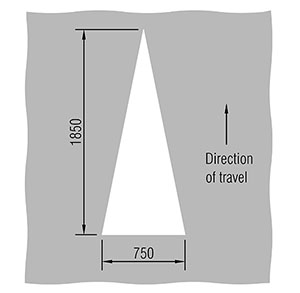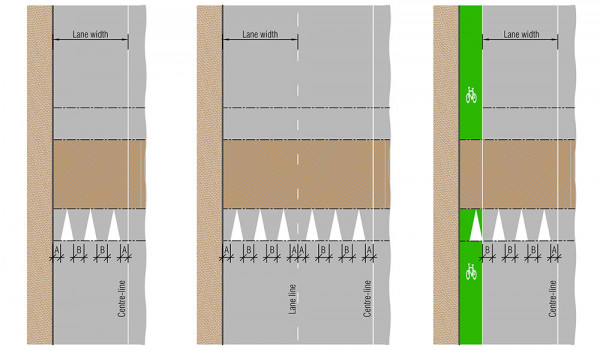Where a vertical deflection device is installed, hump ramp markings should be marked as specified in Table 14‑1.
Table 14-1: Hump ramp markings
| Application | |
|---|---|
| Colour | Reflectorised white |
| Width | 750mm |
| Length | From the base of the ramp to the apex of a sinusoidal device or to the top of the ramp for a platform, table, or cushion, but no greater than 1850mm (see Figure 14‑1). |
The following guiding principles should be applied:
Figure 14‑1: Hump ramp markings dimensions

Figure 14‑2: General layouts for hump ramp markings

View larger image [JPG, 153 KB]
Table 14‑2: Spacings for hump ramp markings on full width devices
| Dimension | Minimum distance (m) | Maximum distance (m) |
|---|---|---|
| A | 0.0 | 0.45 |
| B | 0.3 | 0.6 |
A centre-line should be marked in advance of a vertical deflection device and may be marked on the device; this applies to all two-way roads including those that do not otherwise have a marked centre-line. However, where a vertical deflection device is used at an intersection or pedestrian facility, the relevant sections of this manual or TCD manual Part 4 may not allow for centre-lines to be marked.
Where a centre-line is to be marked for a vertical deflection device the centre-line should be continuous for a minimum length of 30m in advance of the ramp.
The type of centre-line should match the existing centre-line markings, otherwise a 100mm wide solid white line should be marked.
Where more than one lane is available for traffic travelling in the same direction on either a one‑way or a two‑way road, the lanes should be separated with lane line markings as described in lane lines and typically three hump ramp markings should be used in each lane. However, depending on lane width, it may be appropriate for there to be two or four hump ramp markings in each lane. Care should be taken to ensure that it is evident to road users which line marks the division between opposing streams of traffic; refer to standard centre-lines.
However, where a vertical deflection device is used at an intersection or pedestrian facility, the relevant sections of this manual or TCD manual Part 4 may not allow lane lines to be marked.
If one or more lanes on approach to a vertical deflection device are special vehicle lanes and the lane line is interrupted to accommodate the device, care should be taken to ensure road users are aware of the restrictions on lane use beyond the vertical deflection device.
Where a vertical deflection device is used at an intersection or pedestrian facility, the relevant sections of this manual or TCD manual Part 4 may not allow edgelines to be marked. Otherwise: